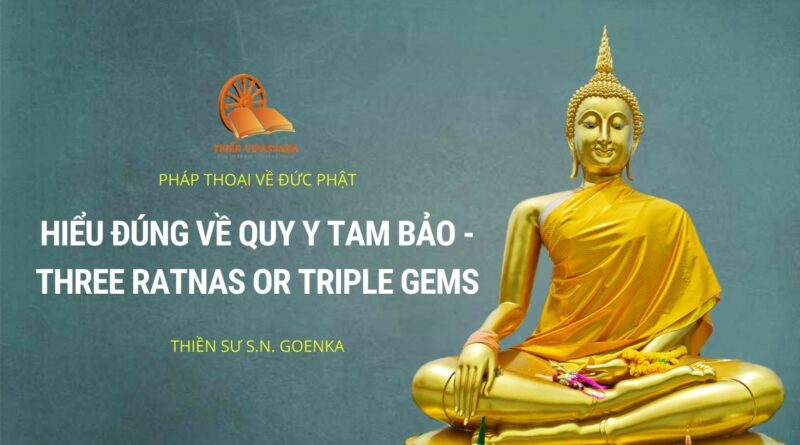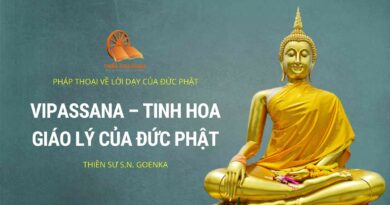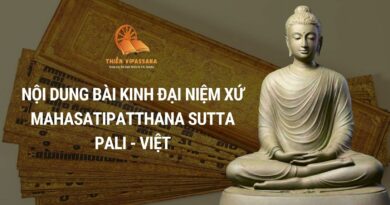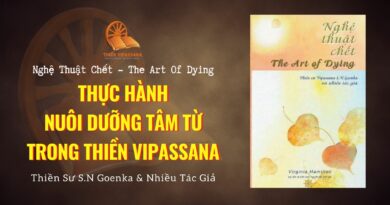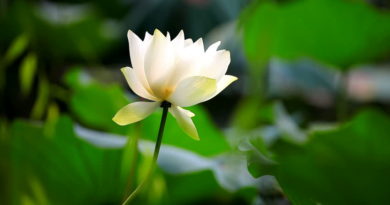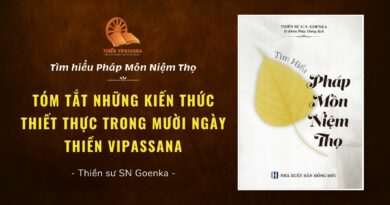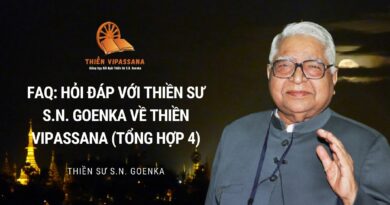Three Ratnas or Triple Gems – Tam Bảo
In this important seminar, I would also like to make a few clarifications about the Three Ratnas or Triple Gems. At the beginning of a Vipassana course, every student, irrespective of his background, takes refuge in the Triple Gems.
Trong hội nghị quan trọng này, tôi cũng muốn làm rõ một vài điều về Tam Bảo. Khi bắt đầu một khóa học Vipassana, mọi thiền sinh, bất kể đến từ nền tảng, đều cần phải quy y Tam Bảo.
What are the Triple Gems? One says, ‘I take refuge in the Buddha; I take refuge in Dhamma; I take refuge in the Sangha’. As time passed, taking refuge in these Three Ratnas was wrongly considered as getting converted from one organized religion to another organized religion. But when understood in its proper perspective, in its original meaning, then not only ordinary people, but also priests, nuns, leaders of different religions have shown no hesitation in taking refuge in the Triple Gems.
Tam Bảo là gì? Một người nói, ‘Tôi quy y Phật; Tôi quy y Dhamma; Tôi quy y tăng già’. Thời gian trôi qua, việc quy y trong Tam Bảo này đã bị coi là sai lầm khi được chuyển đổi từ tôn giáo có tổ chức này sang tôn giáo có tổ chức khác. Nhưng khi được hiểu theo quan điểm đúng đắn, theo nghĩa gốc, thì không chỉ những người bình thường, mà cả các linh mục, nữ tu, các nhà lãnh đạo của các tôn giáo khác nhau đã không tỏ ra ngần ngại khi nương tựa vào Tam Bảo.
The Buddha has so clearly and unambiguously explained the meaning of the Three Ratnas as Dhamma qualities, when he said:
Đức Phật đã giải thích rất rõ ràng về ý nghĩa của Tam Bảo là phẩm chất của Dhamma, khi ngài nói:
“Idampi Buddhe ratanam panitam,
Idampi Dhamme ratanam panitam,
Idampi Sanghe ratanam panitam.”
He explains the Triple Gems as virtuous qualities in each of them. And one is taking refuge in these qualities, and not in the person or persons.
Ngài giải thích Tam Bảo là phẩm chất đạo đức trong mỗi người. Và một người đang nương tựa vào những phẩm chất này, và không phải là nương tựa ở chính họ hay ở người khác.
The real teaching of the Enlightened One does not want anybody to take refuge in Gotama, the Buddha, nor to take refuge in ‘Buddhist’ Dhamma’, nor in ‘Buddhist Sangha’. When we take away these confusing prefixes from these words and understand the real meaning of the Three Ratnas, it becomes acceptable to one and all. This is because, when one takes refuge in a Ratna, one takes refuge not in a person, but in the virtuous quality of that person for getting inspiration to develop those very qualities within oneself.
Giáo lý thuần khiết của Đấng giác ngộ không muốn bất kỳ ai nương tựa vào Gotama, Đức Phật, cũng không phải quy y ‘Phật pháp’, cũng như trong ‘Tăng đoàn Phật giáo’. Khi chúng ta hiểu ý nghĩa thực sự của Tam Bảo, nó sẽ là phổ quát cho tất cả. Điều này là bởi vì, khi ta quy y Tam Bảo, không nương tựa vào một người, mà là phẩm chất đạo đức của người đó để có được cảm hứng phát triển những phẩm chất đó trong chính họ.
When one takes refuge in Buddha Ratna, one takes refuge in the qualities of the Buddha, which is enlightenment. And this enlightenment is not limited to a particular sect or community. Everyone has the seed of enlightenment within oneself, but one has to work very hard, for many lives, to gradually develop and get fully enlightened. Full enlightenment is not the monopoly of only Siddhartha Gotama. He repeatedly said there were many Buddhas before and there will be many Buddhas after him.
Khi ta quy y Tam Bảo của Đức Phật, là ta đang quy y những phẩm chất của Đức Phật, đó là sự giác ngộ. Và sự giác ngộ này không giới hạn trong một giáo phái hay cộng đồng cụ thể. Mọi người đều có hạt giống giác ngộ trong chính mình, nhưng người ta phải làm việc rất chăm chỉ, trong nhiều kiếp, để dần dần phát triển và được giác ngộ hoàn toàn. Sự giác ngộ hoàn toàn không phải là sự độc quyền của chỉ Siddhartha Gotama. Ngài đã nhiều lần nói rằng có nhiều vị Phật trước ông và sẽ có nhiều vị Phật sau ông.
Similarly, when one takes refuge in Dhamma Ratna, one is taking refuge in the quality of the universal Dhamma, i.e., sila (morality), samadhi (mastery over the mind) and panna (purificaiton of the mind by one’s insight).
Tương tự như vậy, khi người ta quy y Dhamma Ratna, người ta sẽ quy y về phẩm chất của Dhamma phổ quát, tức là sila (giới), samadhi (định) và panna (tuệ).
So also, when one takes refuge in the Sangha Ratna, one actually takes refuge in the quality of the Sangha. Anyone who has walked on the path of Dhamma, has purified the mind, liberated oneself from all the mental defilements, keeps on generating love and compassion. Such a saintly person is Sangha; one may belong to any ‘caste’, community, country, gender, it makes no difference. One gets inspiration from any such pure-minded person from whom one feels the confidence of getting guidance for one’s own liberation, and work hard to get established in the right path.
Cũng vậy, khi người ta quy y Tăng già Ratna, người ta thực sự quy y phẩm chất của Tăng già. Bất cứ ai đã đi trên con đường của Dhamma, đã thanh lọc tâm trí, giải thoát bản thân khỏi mọi phiền não, tiếp tục sinh ra tình yêu và lòng trắc ẩn. Tăng như một vị thánh; người ta có thể thuộc về bất kỳ đẳng cấp nào, cộng đồng, quốc gia, giới tính, điều đó không phân biệt. Người ta có được cảm hứng từ bất kỳ người có tâm trí thuần khiết như vậy, từ đó người ta cảm thấy tự tin nhận được sự hướng dẫn cho sự giải thoát của chính mình, và làm việc chăm chỉ để được đi theo con đường đúng đắn.
So, taking refuge in the Triple Gem actually means taking refuge in the universal qualities of Dhamma. This is what the Buddha emphasized again and again. Verily, Buddha is Buddha because of Dhamma. Sangha is Sangha because of Dhamma. Therefore, Dhamma is the highest in the world – Dhammo hi settho janetasmim. And again and again he gave importance to taking refuge in Dhamma. Taking refuge in Dhamma, means the Dhamma within oneself – “Dhareti’ti Dhammo”. This is the real refuge, real shelter, a real island where one can shelter one’s boat in any turbulent storm – Attadipa viharatha, attasarana, anannasarana Dhamma dipa dhammasarana anannasarana
Vì vậy, quy y Tam Bảo thực sự có nghĩa là quy y các phẩm chất phổ quát của Dhamma. Đây là những gì Đức Phật nhấn mạnh nhiều lần. Quả thật, Phật là Phật vì Dhamma. Tăng là tăng thân vì Dhamma. Do đó, Dhamma là cao quý nhất trên thế giới – Dhammo hi settho janetasmim. Và hết lần này đến lần khác, Ngài coi trọng việc quy y Dhamma. Quy y Dhamma, có nghĩa là Dhamma trong chính mình – “Dhareti’ti Dhammo”. Đây là nơi nương tựa thực sự, một hòn đảo thực sự nơi người ta có thể trú ẩn thuyền của mình trong bất kỳ cơn bão hỗn loạn nào – Attadipa viharatha, attasarana, anannasarana Dhamma dipa dhammasarana anannasarana
The Buddha stressed that Dhamma developed within oneself should be one’s own shelter, and emphatically declared (na anna saranam) – no refuge in anyone else. He said one is one’s own master (“atta hi attano natho”), one makes one’s future oneself (atta hi attano gati); and then he emphatically says you have to work out your own salvation (“tumhe hi kiccam attappam“), and the Enlightened Ones only show the true Path (“akkhataro Tathagata” ). One has to make every effort to walk on the Path.
Đức Phật nhấn mạnh rằng Dhamma phát triển trong chính mình nên là nơi nương tựa của chính mình, và tuyên bố dứt khoát (na anna saranam) – không nương tựa vào bất kỳ ai khác. Ngài nói một người là chủ nhân của chính mình (Tự atta hi attano natho), một người làm cho chính mình trong tương lai (atta hi attano gati); và sau đó Ngài dứt khoát cho rằng ta phải tự mình thực hiện sự cứu rỗi (“tumhe hi kiccam attappam”), và Bậc giác ngộ chỉ chỉ ra Con đường thực sự (“akkhataro Tathagata”). Người ta phải nỗ lực hết sức để bước đi trên Con đường đó.
So taking refugee in Three Ratnas is not a sectarian rite or ritual, as is well understood by Vipassana meditators. This helps to free people from sectarian bondages and dogma, and helps them live a life of Dhamma, a life which every religion actually wants one to.
Vì vậy, quy y Tam Bảo không phải là một nghi thức hay nghi lễ giáo phái, như các thiền giả Vipassana hiểu rõ. Điều này giúp giải thoát mọi người khỏi sự ràng buộc giáo phái và giáo điều, và giúp họ sống một cuộc đời của Dhamma, một cuộc sống mà mọi tôn giáo thực sự muốn.
Nguồn VRIDhamma.org

